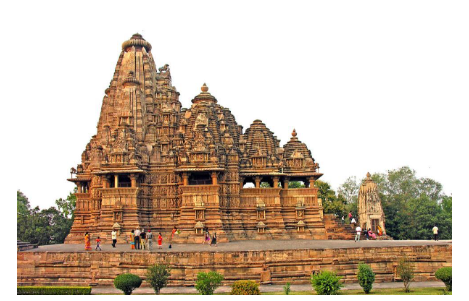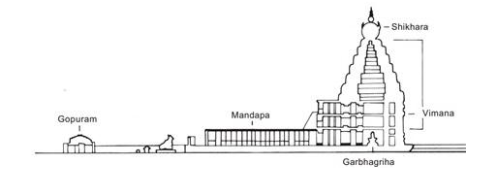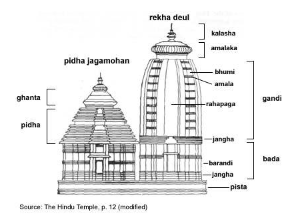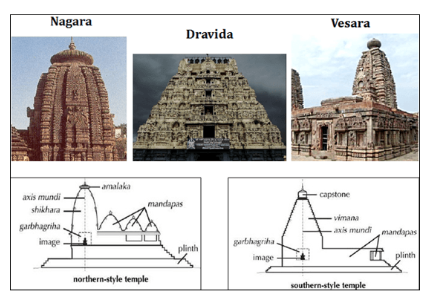The history of temple development in India is a fascinating journey that spans several millennia and is deeply intertwined with the evolution of Indian civilization, religious beliefs, and architectural prowess.
Temple architecture in India is diverse and rich, representing a wide range of artistic styles, construction techniques, and religious influences. Each region of India has its unique temple architecture, shaped by historical, cultural, and local artistic traditions.
Key phases in the development of temples in India:
INITIAL PHASE
- Early Period (Prehistoric to 3rd Century BCE): During the prehistoric and early historical periods, the worship of natural elements, spirits, and ancestral deities was prevalent. These early practices involved the construction of simple shrines, rock-cut caves, and megalithic structures. As urban centers emerged and trade flourished, the architectural techniques evolved, leading to the construction of more sophisticated structures.
- Maurya and Shunga Periods (3rd Century BCE to 1st Century BCE): Under the Mauryan and Shunga dynasties, Buddhism gained prominence, and the rock-cut caves, such as those at Barabar and Nagarjuni, were built to serve as monastic retreats. Some of the earliest freestanding stone temples were also constructed during this time, like the Great Stupa at Sanchi.
- Gupta Period (4th to 6th Century CE): The Gupta period is often considered the golden age of Indian art and architecture. It witnessed significant developments in temple construction. Hindu temple architecture started to take shape during this period with the construction of stone temples. The temples were generally characterized by a square sanctum with a flat roof, mandapa (hall) with pillared porticos, and intricate sculptural work. The Dashavatara Temple in Deogarh and the early structures at the Elephanta Caves are notable examples from this era.
ADVANCE PHASE (6th Century onwards)
Nagara School of Architecture (North Indian Temple Architecture):
- Origin and Popularity: The Nagara style of temple architecture became popular in northern India from the 5th Century AD onwards.
- Stone Platform: Temples are typically built on stone platforms with steps leading up to the main entrance.
- Absence of Elaborate Boundary Walls: Unlike South Indian temples, Nagara temples usually lack elaborate boundary walls and gateways.
- Location of Garbhagriha: The sanctum, known as the garbhagriha or vimana, is always located directly under the tallest tower (shikhara).
- Subdivisions of Shikhara: Nagara temples have different subtypes of shikhara, with variations in shape and design.
- Latina or Rekha-Prasada: Square base with inwardly curving walls, culminating in a point on top.
- Phamsana: Broader base and shorter height, with a straight-sloping roof composed of several slabs.
- Vallabhi: Rectangular base with a roof rising into vaulted chambers.
- Panchayatan Style: Temples often follow the Panchayatan style, featuring subsidiary shrines laid out in a cruciform pattern around the main shrine.
- Mandapas: Temples have assembly halls or mandaps in front of the main shrine, serving as gathering spaces for religious ceremonies and rituals.
- River Goddess Images: Images of the river goddesses Ganga and Yamuna are commonly placed outside the garbhagriha.
- Lack of Water Tanks: Generally, Nagara temples do not have water tanks or reservoirs within the temple premises.
- Pillared Approach: The porticos of the temples have a pillared approach.
- Amalak and Kalash: At the top of the shikhara, there is a fluted disc called Amalak, followed by a spherical structure known as Kalash.
Dravida or South Indian Temple Style
- Enclosed Compound Wall: Unlike Nagara temples, Dravida temples are enclosed within a compound wall.
- Gopuram Entrance: The front wall of the temple has a central entrance gateway known as a gopuram.
- Stepped Pyramid Vimana: The main temple tower, called vimana in Tamil Nadu, has a stepped pyramid shape that rises geometrically, unlike the curving shikhara of North Indian temples.
- Presence of Temple Tank: It is common to find a large water reservoir, known as a temple tank, enclosed within the temple complex.
- Subsidiary Shrines: Subsidiary shrines can either be incorporated within the main temple tower or located separately beside the main temple.
- Famous Temple Towns: Kanchipuram, Thanjavur (Tanjore), Madurai, and Kumbakonam are renowned temple towns in Tamil Nadu, where temples played a significant role as administrative centers controlling vast land areas during the 8th-12th centuries.
- Subdivisions of Dravida Temples: Dravida temples have five different basic shapes:
- Square (Kuta or Caturasra)
- Rectangular (Shala or Ayatasra)
- Elliptical (Gaja-prishta or Vrittayata)
- Circular (Vritta)
- Octagonal (Ashtasra)
- Pallavas and their Influence: The Pallavas, an ancient South Indian dynasty, spread their empire across various regions, with strong connections to South-East Asia. Their early temples were rock-cut, while later ones were structural.
- Mahabalipuram Temples: Mahendravarman I, a Pallava king, is credited with early rock-cut temples. Narasimhavarman I (Mamalla) initiated significant building works in Mahabalipuram, where the famous Shore Temple was likely constructed during the reign of Narasimhavarman II (Rajasimha).
- Shore Temple Features: The Shore Temple houses three shrines, two to Shiva (facing east and west) and a middle one to Vishnu. Sculptures of Nandi, Shiva’s mount, adorn the temple walls, but erosion due to salt-laden air has affected some carvings over the centuries.
- The Rajarajeswara Temple in Thanjavur: Magnificent Shiva Temple: The Rajarajeswara or Brahadeeshwarar temple in Thanjavur is a magnificent Shiva temple, completed around 1009 CE by Rajaraja Chola. It holds the distinction of being the largest and tallest of all Indian temples. The temple features two large gopurams (gateway towers) that are noteworthy for their elaborate sculptural program. This unique feature was conceived along with the temple itself.
Vesara Style
The Vesara style is a fusion of the Nagara and Dravida styles, often found in temples in central India. It combines elements of both northern and southern architecture and exhibits a mix of features:
- A square-shaped sanctum with a Nagara-style tower and Dravida-style pyramidal tower.
- Protruding balconies with miniature shrines and sculptures.
- Elaborate carvings on the temple walls and pillars.
- Prominent examples: Hoysala temples like the Chennakesava Temple in Somanathapura, Elephanta Caves in Maharashtra.
Vesara-Nagara Hybrid Style: This style emerged during the Chalukya and Rashtrakuta periods and is a blend of Nagara and Vesara elements:
- Square sanctum with a curvilinear shikhara.
- A stepped pyramidal tower over the sanctum.
- Decorative motifs and intricate carvings similar to the Vesara style.
- Prominent examples: Virupaksha Temple in Pattadakal, Mallikarjuna Temple in Basaralu.
Kalinga Style (Odisha Style)
The Kalinga style is unique to the state of Odisha and is characterized by its emphasis on the sanctum, which is circular in shape. Key features include:
- Curvilinear tower (rekha adult) over the sanctum with a crowning element called amalaka.
- Pyramid-shaped hall (jagamohana) leading to the sanctum.
- Sculptures depicting various aspects of Hindu mythology.
- Prominent examples: Lingaraja Temple in Bhubaneswar, Sun Temple in Konark.
Basic Features of Indian Temple
Indian temple architecture exhibits several basic features that are common across different styles and regions. These features are integral to the design and symbolism of Hindu temples. Here are some of the key elements:
- Sanctum (Garbhagriha): The sanctum, also known as garbhagriha or vimana, is the core and most sacred part of the temple. It houses the main deity or presiding deity of the temple. The sanctum is usually a small, dark chamber where the deity resides. It is often designed to represent the cosmos, symbolizing the womb of creation and the abode of the divine.
- Mandapa: The mandapa refers to the pillared hall or porch that serves as the entrance to the sanctum. It acts as a gathering space for devotees, where religious ceremonies and rituals are performed. The mandapa can be open or closed, depending on the architectural style of the temple.
- Shikhara (Spire): The shikhara is the towering superstructure that rises above the sanctum. It is the most prominent and recognizable feature of Indian temples. The shape and design of the shikhara vary depending on the regional architectural style. In North Indian temples, the shikhara is often curvilinear, resembling a mountain peak, while in South Indian temples, it is pyramidal and has a stepped design.
- Gopuram (Gateway Tower): In South Indian temple architecture, especially in Dravida-style temples, the gopuram is a monumental and ornate tower that stands at the entrance to the temple complex. It is adorned with elaborate sculptures and serves as a grand gateway, leading devotees into the temple precinct.
- Amalaka and Kalasha: The amalaka is a circular stone disc placed at the top of the shikhara in many North Indian temples. It serves as a crown for the temple tower. Above the amalaka, a kalasha (decorative finial) is placed, representing a pot of nectar or abundance.
- Pillars and Columns: Indian temple architecture features intricately carved pillars and columns. These pillars support the roof of the mandapa and other parts of the temple. The carvings on the pillars often depict scenes from Hindu mythology, celestial beings, and other ornate designs.
- Sculptures and Carvings: Sculptures and carvings are essential elements of Indian temple architecture. They adorn the exterior walls, entrance gateways, and inner sanctum of the temple. The sculptures depict various deities, gods, goddesses, celestial beings, mythical creatures, and scenes from Hindu epics and Puranas.
- Temple Tank: Many Indian temples have a sacred water tank or reservoir known as a temple tank or kund. These tanks are used for ritual bathing and other religious ceremonies. They also serve a practical purpose by providing water for temple-related activities.
- Pradakshina Path: The pradakshina path is a circumambulatory path around the inner sanctum of the temple. Devotees walk in a clockwise direction around the sanctum as part of their worship, symbolizing their reverence and devotion to the deity.
- Vastu Shastra and Symbolism: Indian temple architecture follows Vastu Shastra, an ancient architectural science that prescribes rules for temple construction. Temples are designed to align with cosmic forces and represent the macrocosm within the microcosm. Each element of the temple has symbolic significance, reflecting the philosophical and spiritual beliefs of Hinduism.
Significance Of Temple Architecture In India
The significance of temple architecture in India is multifaceted and deeply rooted in the country’s culture, religion, history, and social fabric. Temples hold a central role in Indian society, and their architecture carries immense importance for various reasons:
- Religious and Spiritual Significance: Temples serve as places of worship and devotion, where people come to connect with the divine. They are considered abodes of gods and goddesses, providing a sacred space for individuals to seek blessings, offer prayers, and perform rituals. The architecture is designed to create a sense of awe and reverence, facilitating a deeper spiritual experience.
- Symbol of Cultural Identity: Temples are iconic symbols of India’s rich cultural heritage. Their architecture reflects the diverse artistic styles, craftsmanship, and architectural achievements of different periods in history. The temple structures often embody the regional, religious, and social identities of the communities they represent.
- Preservation of Art and Craftsmanship: Temple architecture has been a significant patron of various art forms. Sculptors, artisans, and craftsmen have created intricate carvings, statues, and frescoes, showcasing their skills and preserving traditional art forms that might otherwise have been lost over time.
- Social and Community Center: Temples play a crucial role in fostering social cohesion and community bonding. Festivals, cultural events, and religious gatherings held in temples bring people together, promoting a sense of unity and solidarity among community members.
- Educational Purposes: Temples have historically been centers of learning, where knowledge of various subjects, including philosophy, music, dance, and sciences, was imparted. Many ancient Indian temples had attached educational institutions, contributing to the dissemination of knowledge.
- Architectural and Engineering Marvels: Indian temple architecture showcases the advanced knowledge of mathematics, engineering, and astronomy possessed by ancient Indian civilizations. The precision in construction, use of specific materials, and alignment with astronomical events highlight the scientific acumen of the builders.
- Historical Insights: Temples are valuable repositories of historical information. They provide insights into the religious practices, socio-cultural dynamics, and political scenarios of different periods in history.
- Tourism and Economy: Temples attract millions of tourists from India and around the world, contributing significantly to the country’s economy. Temples often serve as major tourist destinations, promoting local businesses and generating revenue for the region.
- Environmental Harmony: Traditional temple architecture often incorporates eco-friendly elements that harmonize with nature, such as rainwater harvesting, ventilation techniques, and the use of natural materials. These practices promote environmental sustainability and conservation.
Overall, temple architecture in India transcends its physical existence; it embodies the collective beliefs, values, and aspirations of the people, making it an integral part of the country’s cultural fabric and national identity.








